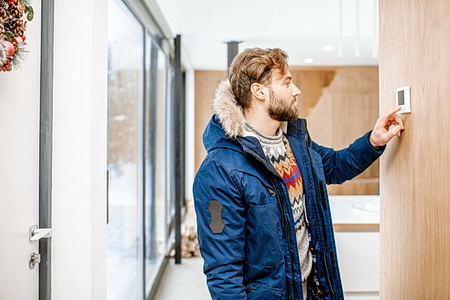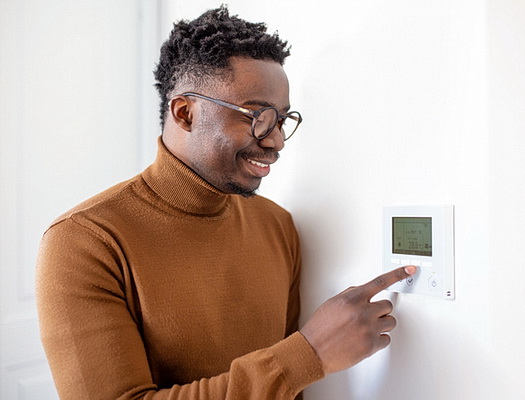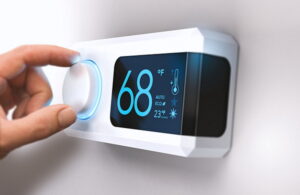
Don’t Let Your Pipes Freeze
If you own a home, you should be aware that if you leave your house in the winter for an extended period and the temperature is 32° or below, you must make sure your thermostat is set to be above freezing temperature, or else you stand the danger of having your pipes freeze, which can become a costly inconvenience. Not to mention the discomfort of being in a cold house until the heating technicians or plumbers come to fix it. Bottom line: Freezing pipes can burst, causing major damage and expensive repairs.
It’s a Simple Procedure But Does Depend on a Few Factors
Striking a balance between conserving energy and safeguarding your home is essential. Here’s what you can do.
The Department of Energy (DOE) suggests a general guideline for thermostat settings during the winter. When you’re at home and awake, a comfortable setting is around 68°F. At night, when you are sleeping, you can lower the temperature to about 10-15°F from the 68°, which helps you save on energy costs. However, it’s essential to avoid excessively low temperatures that might put your pipes at risk of freezing, although one would wonder why someone would lower their temperature to freezing while they are home.
What is the Trigger Point Where the Pipes Will Freeze?
The critical threshold to prevent frozen pipes is generally considered to be around 32°F, which is the standard temperature for freezing. Water turns to ice at this temperature. Keeping your thermostat above 32° is crucial to ensure that the pipes remain unfrozen. But just don’t keep it at 33° or 34°. That is too close to the danger point. Better to set the thermostat to at least 55°F, especially when you’re away for an extended period. This will help to maintain a safe buffer and you will not come home to a busted pipe.
If you have vulnerable areas in your house, such as unheated basements or crawl spaces, consider adjusting the thermostat slightly higher to provide extra protection for the pipes in these areas. Pipes located near exterior walls or in poorly insulated spaces are more susceptible to freezing, so paying attention to these areas is crucial.

There are some additional measures you can take to further reduce the risk of frozen pipes:
- Insulation: Adequate insulation is a key defense against frozen pipes. Ensure that pipes in vulnerable areas are well-insulated. This is particularly important for exterior walls, unheated spaces, and areas with limited insulation.
- Faucet Dripping: Allowing faucets to drip slowly can prevent pipes from freezing. Moving water is less likely to freeze, so even a small, continuous drip can make a significant difference, especially in extremely cold weather.
- Open Cabinet Doors: If you have pipes located inside cabinets, especially along exterior walls, leave the cabinet doors open to allow warmer air to circulate the pipes. This helps prevent cold spots that could lead to freezing.
- Sealing Drafts: Seal any gaps or drafts in windows, doors, or other openings. This helps maintain a warmer indoor environment, reducing the likelihood of pipes freezing.
- Smart Thermostats: Consider upgrading to a smart thermostat, which allows for more precise control over temperature settings. PSEG in Long Island offers a variety of these smart devices. And if you live in NYC, Con Edison also offers smart thermostats.
- Remote Monitoring: This is another advantage of having a smart thermostat. Most have remote monitoring systems that can alert you to potential issues with temperature in your home. Some smart home systems can send notifications to your smartphone if the temperature drops below a certain threshold.
- The duration of your absence: If you’re only going to be gone for a few hours, you can probably get away with setting the thermostat a bit lower. But for longer absences, it’s better to err on the side of caution and keep it at 55°F (13°C) or higher.
- The type of pipes you have: Copper pipes are more susceptible to freezing than plastic pipes. So, if you have copper pipes, you’ll want to be extra careful and keep the thermostat at 55°F (13°C) or higher, even in milder climates.
- The location of your pipes: Pipes that are exposed to the elements, such as those in exterior walls or crawl spaces, are more likely to freeze than pipes that are located inside your home. So, you may want to take extra precautions to protect these pipes, such as insulating them or wrapping them with heat tape.
Conclusion

Always keep your thermostat above 32°F in winter and if you go away for an extended period, you can set it to around 55°. This will ensure that your pipes won’t freeze but also keep energy consumption low. You can also follow the other suggestions mentioned here, but you should tailor these recommendations based on your specific home setup, climate conditions, and the duration of your absence. Taking proactive steps to protect your pipes ensures a worry-free return home and avoids the potential hazards and costs associated with frozen pipes.
Patricia Scanlon is a traffic ticket attorney who services clientele in Long Island, NYC, and throughout NYS.